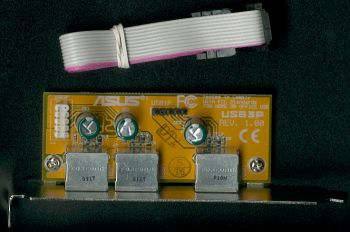BX Flagship: Asus CUBX
The Asus CUBX, Continued
As you know, the BX chipset itself does not support UltraDMA/66. Even so, Asus integrated an additional UltraDMA/66 IDE controller chip from CMD, adding two IDE channels. Thanks to this, the CUBX comes with a total of four IDE ports (allowing up to eight drives). Of course this UDMA/66 chip can be disabled in the BIOS, as it is a bit sensitive. At 37.5 MHz PCI-clock, which you get when running the FSB at 150 MHz, the little chip didn't want to work any more. I got no problems at 133 MHz FSB (=33 MHz PCI clock). I recommend to be careful with timing sensitive devices like controller chips. They usually dislike being overclocked and the worst that can happen is unnoticed data corruption.
The CUBX has no less than five USB ports. As always, the first two are situated between the I/O ports and the keyboard and mouse connectors. Many other boards feature four USB ports as well, but only few come with the right adapter or cable to use them. Asus includes everything that is necessary.
I think that there's hardly any need to talk about Asus' manuals. They are always very comprehensive and detailed. This one comes with a thorough BIOS description, which should make the setup quite painless. Asus did not the best work regarding the board's design as the floppy connector has been placed before the first two PCI slots. That makes the floppy cable having to run across the AGP card, which inhibits proper cooling of this card.
The CUBX provides three fan headers and the usual wake on LAN or wake on modem features. The connector block has been labeled appropriate, but still there's some space for improvements. Let's now take a quick look at the benchmark results.
Get Tom's Hardware's best news and in-depth reviews, straight to your inbox.

Patrick Schmid was the editor-in-chief for Tom's Hardware from 2005 to 2006. He wrote numerous articles on a wide range of hardware topics, including storage, CPUs, and system builds.
